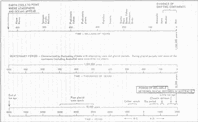


Memories of the Bureau, 1946 to 1962
Foreword
Terminology
Prologue
Preface
Chapter 1: The Warren Years, 1946 to 1950
Chapter 2: International Meteorology
Chapter 3: The Timcke Years, 1950 to 1955
Chapter 4: A Year at the Massachusetts Institute of Technology
Melbourne to Cambridge, Massachusetts
Long-range Forecasting
Synoptic Meteorology
Dynamic Meteorology I, II, III
Dynamic Meteorology IV
Physical Meteorology
Seminars
Audrey Joins Me in Boston
Was it Worthwhile?
Chapter 5: The Dwyer Years, 1955 to 1962
Chapter 6: A Springboard for the Future
Appendix 1: References
Appendix 2: Reports, Papers, Manuscripts
Appendix 3: Milestones
Appendix 4: Acknowledgements
Appendix 5: Summary by H. N. Warren of the Operation of the Meteorological Section of Allied Air Headquarters, Brisbane, 1942–45
Endnotes
Index
Search
Help
Contact us

Long-range Forecasting (continued)
Lectures by Willet in the second semester dealt with possible correlations between solar indices, sunspot numbers, and variations in solar radiation (the solar constant), geomagnetic variations, oscillations in pressure differences between 'centres of action', influence of extent of polar ice packs, the effect of variations in sea-surface temperature, the use of synoptic analogues (after Irving Crick) and the many other methods used by extended period and long-range forecasters.This comprehensive review of attempts to make extended period and long-range forecasts based on the wide variety of indices and indicators referred to in the previous paragraph did not create much optimism for success. One problem was to find a method of verifying such forecasts many of which were somewhat circumlocutionary. The lectures provided a salutary message that extended period and long-range forecasts needed a comparison with observed atmospheric conditions over lengthy periods.
In view of the current interest in the Southern Oscillation and El Niņo it is interesting to note that Willet's lectures referred us to investigations of the oscillation of pressure indices as a method of long-range forecasting. Gilbert Walker had computed the oscillation of the difference in pressure between 'centres of action' in the North Atlantic, North Pacific and Southern Oceans where he believed there may be teleconnections with rainfall in adjacent continents. He found that the Southern Oscillation showed a significant correlation with Indian rainfall. Willet referred us to Supplement No 39 of the US Weather Bureau's Monthly Weather Review for further details.
The lectures by Willet in the third semester dealt with historical and geological evidence of climatic change. This part of the course was to prove valuable in the 1970s when the subject became a matter of widespread public interest.

Willet's lectures also discussed the evidence of the 200 year data bank of reliable meteorological observations, the 2000 year historical record and the geological eras extending back as far as 750 million years.
He suggested that this information indicated possible cycles in climate over the last 200 years and that historical evidence of variation in the extent of Arctic and Antarctic pack ice, and of inland lakes and glaciers may provide evidence of, or be the cause of, variability of climate. He pointed out that periodic fluctuations of the number of sunspots on the sun was also considered to be a likely cause of climatic fluctuations and that the geological evidence of past ice ages demonstrated a scale of climatic variability with much larger amplitude and much longer periodicity.
 |
Bureau of Meteorology |  |
© Online Edition Australian Science and Technology Heritage Centre and Bureau of Meteorology 2001
Published by Australian Science and Technology Heritage Centre, using the Web Academic Resource Publisher
http://www.austehc.unimelb.edu.au/fam/1002.html